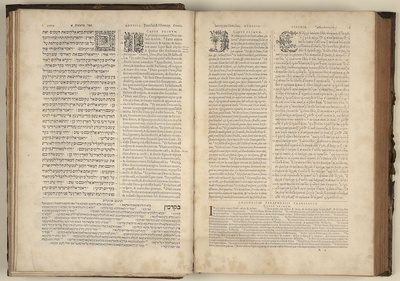
The Bible in Greek
The Hebrew Bible was translated into Greek in the third and second centuries BCE. This text become known as the Septuagint, the "Translation of the Seventy", after the number of Jewish scholars that were said to have produced it.
The text - which includes apocryphal and deuterocanonical books - became hugely influential. It was widely used in the time of Early Christianity. Modern critical editions of the Greek Old Testament are based on late-antique manuscripts of the Septuagint.
This version of the Old Testment in Greek gives the edition by Henry Barclay Swete, a British biblical scholar. In 1894, Swete completed his edition of the Greek text of the Old Testament.
This part of the Bible in Greek gives the revised edition of Swete's texts (from 1901–7). These texts are in the public domain. The Open Greek and Latin group has created CTS compliant TEI XML for it (slightly changed by Brill). The resulting publication is in Open Access.
The texts that comprise the New Testament were all originally written in the Greek language spoken in the Eastern Mediterranean in the Hellenistic and Roman periods. They were later translated into other ancient languages, such as Syriac, Latin, and Coptic.
This version of the New Testament in Greek gives the edition published by Biblical scholars Brooke Foss Westcott and Fenton John Anthony Hort in 1881. It is known as The New Testament in the Original Greek or simply the Westcott and Hort text.
This part of the Bible in Greek therefore gives the edition by Westcott and Hort. These texts are in the public domain. The Perseus Digital Library has created CTS compliant TEI XML for it (slightly changed by Brill). The resulting publication is in Open Access.
Brill Polyglot Bible is not a scholarly publication. It is a showcase of possibilities.
The aim is to collect the books of the Bible in the major languages of the ancient world and to publish them in CTS compliant TEI XML on Brill Scholarly Editions.
In this way, each Biblical passage has a persistent and unique identifier and can be retrieved. This means, for example, that a reference to a Biblical passage in a monograph or journal article can be turned into a hyperlink, so readers can review the passage and its context.
A further possibility is to connect the passages to Biblical iconography using the Iconclass classification system, so readers can go from, for example, an image of the annunciation in the Lexikon der christlichen Ikonographie Online to Luke 1:26-38 in the Brill Polyglot Bible and vice versa.
Brill Polyglot Bible is in Open Access.